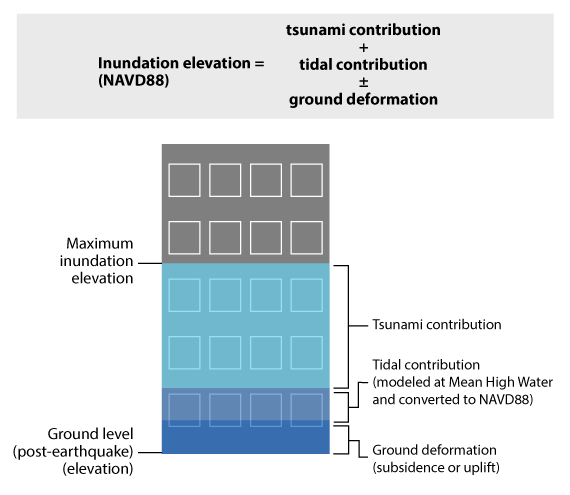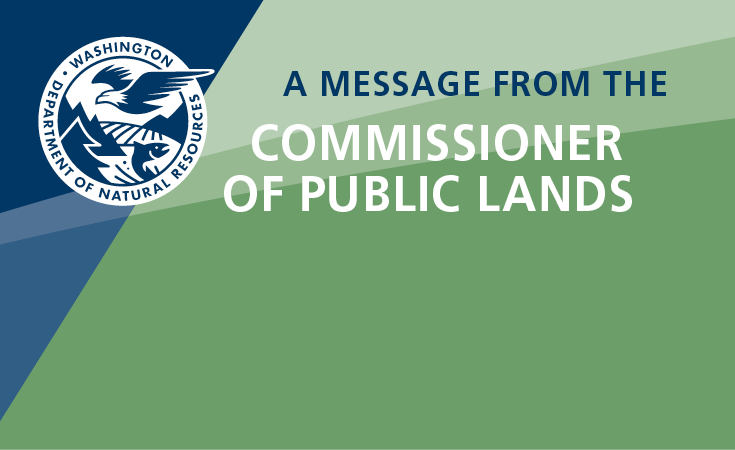Washington State's adoption of the 2018 and 2021 International Building Code (IBC) included amendments to the original code language to direct designers, engineers, and architects to use Washington Tsunami Design Zone (WA-TDZ) maps, where available, to determine whether structures in Risk Categories III or IV need to be designed for tsunamis.
Specifically, the code requires that certain tsunami-related design parameters be considered if a structure is located in a tsunami inundation area as mapped in the WA-TDZ. Additionally, any site-specific tsunami inundation studies must use WA-TDZ offshore amplitude data points as a baseline in their analysis. In support of these code requirements, the Washington Department of Natural Resources (DNR) maintains a series of WA-TDZ maps on this webpage.
Below you will find the 2018 and 2021 WA-TDZ maps. The 2021 WA-TDZ went into effect March 15, 2024 and was updated July 31, 2024. Both the 2018 and 2021 WA-TDZs feature an interactive map where users can access site-specific information, as well as links to download the original map publications that are cited in the respective building codes. Notable changes between these versions are near-complete mapping of inundation statewide and the removal of a Seattle Fault scenario, which was deemed to be beyond the 2,475 recurrence threshold for hazard recurrence.
2021 Tsunami Design Zone
We recommend users jump to their project site or zoom in to an area of interest by using the search tool in our WA-TDZ interactive map (click the picture below to access the map). Due to performance limitations, the tool will not retrieve depth or velocity results while too zoomed out. At minimum the scale bar in the lower left corner of the screen must say “500 ft” to retrieve values from the data, though “100 ft” provides the best performance. The only layers that will be visible at any time are inundation extent and offshore amplitudes. Despite not being visible for performance reasons, the other layers are selectable if zoomed in sufficiently.
Access the 2021 interactive map
User Note: The 2021 WA-TDZ interactive map and geodatabase were both updated on July 31, 2024 to include layers for coseismic deformation and maximum inundation depth, and to remove the inundation elevation layer. Minor spatial corrections were also applied to the layers to better match the source publications. For example, slight shifts were created in the original version due to the way that source rasters were merged to build the statewide dataset. Additionally, data in southwest Washington were recreated to better match the source datasets. Inundation elevation was removed from the layer list as it was a derivative product that was not directly produced from the tsunami models and led to initial confusion by code practitioners. Also, it is likely that the practitioner would have access to site elevation surveys or lidar that would be better used to calculate the design elevation for the site. Design inundation elevations can be calculated by taking the maximum inundation depth across a site and adding it to the grade plane elevation (relative to mean high water) of the site. For locations offshore (below mean high water) the inundation depth includes the water depth to the sea floor.
The interactive map contains:
- Tsunami maximum inundation depth—The maximum depth of design tsunami water level, including relative land level change (subsidence) with respect to the grade plane at the structure. Reported in units of feet. The reported value indicates how high the water will be over the ground surface at the given point after the land has subsided.
- Tsunami maximum current velocity—The maximum velocity of water movement in feet per second at a given point within the inundation extent. Each location provides a singular value of water speed, so surrounding areas need to be considered to establish directionality.
- Tsunami offshore points—Simulated tide gauges (showing amplitude in feet and period in minutes) created at the approximate 100-meter depth contour for use in comparative analysis of site-specific tsunami models or new or revised regional tsunami models.
- Coseismic deformation—Vertical motion of the land surface due to earthquake slip, which permanently (in engineering timescales) changes the land surface elevation relative to global sea level. On land in Washington this is typically represented as subsidence (land falls relative to sea level). Reported in units of feet.
- Tsunami inundation extent—The maximum inland extent of flooding for the maximum considered tsunami. The yellow overlay ends where the inundation depth above grade becomes zero.
- Tsunami study areas—Extent of the source publications used in this map, with citations and hyperlinks to the publications and digital datasets provided.
Building Codes
Washington State's adoption of the 2021 International Building Code (IBC) included an amendment to adopt the ASCE 22 7-22 tsunami loads chapter with amendments that direct designers, engineers, or architects to use the Washington Tsunami Design Zone Maps (WA-TDZ) to determine whether structures in Risk Category III or IV need to be designed for tsunamis. Special design parameters must be considered for these structures if they are located in the WA-TDZ. Further, the code requires the use of Washington DNR Tsunami Inundation Data for design purposes, or that such data be considered as a baseline for self-conducted studies. Please consult the 2021 Washington State Building Code for official language.
All WA-TDZ products are produced from a tsunami inundation model run at the mean high water (MHW) datum and incorporate ground deformation (subsidence) from the earthquake in the inundation depth results. Be aware that the products on this page do not include any contribution from sea level rise. Local sea level rise projections for Washington State are available here: Miller and others, 2018.
2021 WA-TDZ Publications
| Maps adopted for the 2021 Tsunami Design Zone | ||||||
|---|---|---|---|---|---|---|
| Location | Publication | Publication Link | Data Link | |||
| Columbia River | DOGAMI SP-51 | Download | Download | |||
| Outer Coast and Strait area | MS 2022-01 | Download | Download | |||
| Port Angeles and Port Townsend area | MS 2018-03 (Partially superseded by MS 2022-01) | Download | Download | |||
| Puget Sound | MS 2021-01 | Download | Download | |||
| San Juan Islands | MS 2016-01 (Partially superseded on its eastern edge by MS 2021-01) | Download | Download | |||
| Southern Washington coast | MS 2018-01 | Download | Download | |||
Download 2021 WA-TDZ GIS Data
Click here to download a zip file (975 MB) that contains a geodatabase with the feature classes used in the interactive map above, a spreadsheet containing maximum modeled offshore wave amplitudes and periods, and images of offshore amplitude plots.
2018 Tsunami Design Zone
| Maps adopted for the 2018 Tsunami Design Zone | ||||||
|---|---|---|---|---|---|---|
| Location | Publication | Publication Link | Data Link | |||
| Anacortes and Bellingham area | MS 2018-02* | Download | Download | |||
| Elliott Bay Seattle | OFR 2003-14 | Download | Download | |||
| Everett area | OFR 2014-03 | Download | Download | |||
| Port Angeles and Port Townsend area | MS 2018-03 | Download | Download | |||
| San Juan Islands | MS 2016-01* | Download | Download | |||
| Southern Washington coast | MS 2018-01 | Download | Download | |||
| Tacoma area | OFR 2009-9 | Download | Download | |||
*Designers wishing to use the latest maps can find them here.
Datums Used in the 2018 Inundation Calculation
Please note that inundation depth values quoted in both source publications and raw data available from WA DNR are relative to a mean high water (MHW) tidal datum. As this is higher than the standard North American Vertical Datum of 1988 (NAVD 88) used in the IBC, the values listed in the WA DNR data will need to be recalculated according to the differences between NAVD 88 and MHW at the project site. This recalculation to NAVD88 has already been conducted for the data displayed in the map below. The 2018 WA-TDZ maps, model data, and results within the 2018 WA-TDZ interactive map already incorporate ground deformation (subsidence) from the earthquake in the inundation depth/elevation results. The published maps, model data, and results shown here do not include any contribution from sea level rise. Local sea level rise projections for Washington State are available here: Miller and others, 2018.

The finalized inundation elevation is the combination of land level subsidence, MHW conversion, and inundation depth.
We recommend users click the search tool in the webmap below (click the picture below to access the map in fullscreen) to jump to their project site or zoom in to an area of interest. While viewable at all scales, the identify pop-up is best used when zoomed in, or else you may accidentally select numerous adjacent data.
Access the 2018 interactive map
Use limitations
Disclaimer of Warranties. No express or implied warranty of any kind is made regarding the functionality of the interactive map or the information contained therein, including, but not limited to, the warranty of merchantability, warranty of fitness for a particular purpose, or warranties of content, completeness, accuracy, reliability, usefulness, or that use would not infringe on privately-owned rights. Although these digital data and metadata have been processed successfully on computers of WGS, no warranty, expressed or implied, is made by WGS regarding the use of these data on any other system, nor does the fact of distribution constitute or imply any such warranty.
Use at Your Own Risk. The information obtained through this interactive map is only intended to help qualified professionals, such as designers, engineers, and architects, determine which structures in Risk III or IV Categories need to be designed for tsunami loads and the respective baseline inputs to design calculations under the Washington State Building Code.
Limitation on Liability. User agrees there shall not be any liability on the State of Washington, Washington Department of Natural Resources, or their officers, agents, representatives, or employees for any damages allegedly resulting from any use or misuse of this information/product. Under this limitation, there shall be no liability for any damages whatsoever, including but not limited to any damages in contract or tort for compensatory, consequential, punitive, direct, indirect, or special damages such as personal injuries, property damage, loss of profits, or any other losses or expenses.
No Endorsement. Reference herein to any specific commercial product, process, or service by trade name, trademark, manufacturer, or otherwise, does not constitute or imply its endorsement, recommendation, or favoring. Further, the views and opinions of authors expressed herein do not necessarily state or reflect those of the State of Washington or any agency thereof.




